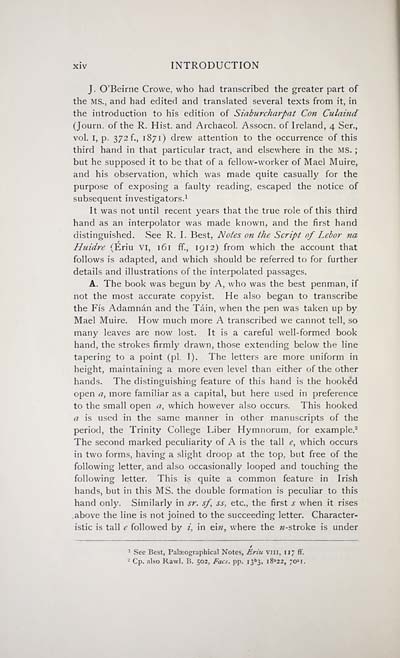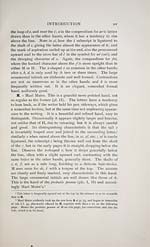Download files
Complete book:
Individual page:
Thumbnail gallery: Grid view | List view

xiv INTRODUCTION
J. O'Beirne Crowe, who had transcribed the greater part of
the MS., and had edited and translated several texts from it, in
the introduction to his edition of Siaburcharpat Con Culaind
(Journ. of the R. Hist, and Archaeol. Assocn. of Ireland, 4 Ser.,
vol. I, p. 372 f., 1 871) drew attention to the occurrence of this
third hand in that particular tract, and elsewhere in the MS. ;
but he supposed it to be that of a fellow-worker of Mael Muire,
and his observation, which was made quite casually for the
purpose of exposing a faulty reading, escaped the notice of
subsequent investigators. 1
It was not until recent years that the true role of this third
hand as an interpolator was made known, and the first hand
distinguished. See R. I. Best, Notes on the Script of Lebor na
Huidre (Eriu VI, 161 ff., 191 2) from which the account that
follows is adapted, and which should be referred to for further
details and illustrations of the interpolated passages.
A. The book was begun by A, who was the best penman, if
not the most accurate copyist. He also began to transcribe
the Fís Adamnán and the Táin, when the pen was taken up by
Mael Muire. How much more A transcribed we cannot tell, so
many leaves are now lost. It is a careful well-formed book
hand, the strokes firmly drawn, those extending below the line
tapering to a point (pi. I). The letters are more uniform in
height, maintaining a more even level than either of the other
hands. The distinguishing feature of this hand is the hooked
open a, more familiar as a capital, but here used in preference
to the small open a, which however also occurs. This hooked
a is used in the same manner in other manuscripts of the
period, the Trinity College Liber Hymnorum, for example. 2
The second marked peculiarity of A is the tall e, which occurs
in two forms, having a slight droop at the top, but free of the
following letter, and also occasionally looped and touching the
following letter. This is quite a common feature in Irish
hands, but in this MS. the double formation is peculiar to this
hand only. Similarly in sr. sf, ss, etc., the first s when it rises
above the line is not joined to the succeeding letter. Character-
istic is tall e followed by z, in ein, where the «-stroke is under
1 See Best, Paloeographical Notes, Eriu Viu, 117 ff.
'-' Cp. also Raw). B. 502, Facs. pp. 13^3, i8 a 22, 70»!.
J. O'Beirne Crowe, who had transcribed the greater part of
the MS., and had edited and translated several texts from it, in
the introduction to his edition of Siaburcharpat Con Culaind
(Journ. of the R. Hist, and Archaeol. Assocn. of Ireland, 4 Ser.,
vol. I, p. 372 f., 1 871) drew attention to the occurrence of this
third hand in that particular tract, and elsewhere in the MS. ;
but he supposed it to be that of a fellow-worker of Mael Muire,
and his observation, which was made quite casually for the
purpose of exposing a faulty reading, escaped the notice of
subsequent investigators. 1
It was not until recent years that the true role of this third
hand as an interpolator was made known, and the first hand
distinguished. See R. I. Best, Notes on the Script of Lebor na
Huidre (Eriu VI, 161 ff., 191 2) from which the account that
follows is adapted, and which should be referred to for further
details and illustrations of the interpolated passages.
A. The book was begun by A, who was the best penman, if
not the most accurate copyist. He also began to transcribe
the Fís Adamnán and the Táin, when the pen was taken up by
Mael Muire. How much more A transcribed we cannot tell, so
many leaves are now lost. It is a careful well-formed book
hand, the strokes firmly drawn, those extending below the line
tapering to a point (pi. I). The letters are more uniform in
height, maintaining a more even level than either of the other
hands. The distinguishing feature of this hand is the hooked
open a, more familiar as a capital, but here used in preference
to the small open a, which however also occurs. This hooked
a is used in the same manner in other manuscripts of the
period, the Trinity College Liber Hymnorum, for example. 2
The second marked peculiarity of A is the tall e, which occurs
in two forms, having a slight droop at the top, but free of the
following letter, and also occasionally looped and touching the
following letter. This is quite a common feature in Irish
hands, but in this MS. the double formation is peculiar to this
hand only. Similarly in sr. sf, ss, etc., the first s when it rises
above the line is not joined to the succeeding letter. Character-
istic is tall e followed by z, in ein, where the «-stroke is under
1 See Best, Paloeographical Notes, Eriu Viu, 117 ff.
'-' Cp. also Raw). B. 502, Facs. pp. 13^3, i8 a 22, 70»!.
Set display mode to: Large image | Transcription
Images and transcriptions on this page, including medium image downloads, may be used under the Creative Commons Attribution 4.0 International Licence unless otherwise stated. ![]()
| Early Gaelic Book Collections > Matheson Collection > Lebor na huidre > (18) |
|---|
| Permanent URL | https://digital.nls.uk/80088493 |
|---|
| Description | Items from a collection of 170 volumes relating to Gaelic matters. Mainly philological works in the Celtic and some non-Celtic languages. Some books extensively annotated by Angus Matheson, the first Professor of Celtic at Glasgow University. |
|---|
| Description | Selected items from five 'Special and Named Printed Collections'. Includes books in Gaelic and other Celtic languages, works about the Gaels, their languages, literature, culture and history. |
|---|

